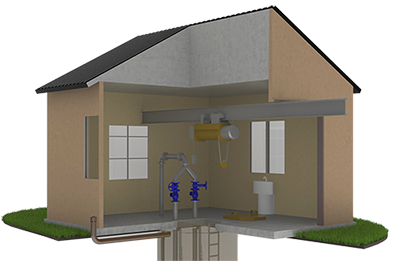When the sewage level rises to a predetermined point, a pump will be started to lift the sewage upward through a pressurized pipe system called a sewer force main or rising main from where the sewage is discharged into a gravity manhole. From here the cycle starts all over again until the sewage reaches its point of destination—usually a treatment plant. By this method, pumping stations are used to move waste to higher elevations. In the case of high sewage flows into the well (for example during peak flow periods and wet weather) additional pumps will be used. If this is insufficient, or in the case of failure of the pumping station, a backup in the sewer system can occur, leading to a sanitary sewer overflow—the discharge of raw sewage into the environment.
Sewage pumping stations are typically designed so that one pump or one set of pumps will handle normal peak flow conditions. Redundancy is built into the system so that in the event that any one pump is out of service, the remaining pump or pumps will handle the designed flow.
Sensors functionality
The pump manufacturers have always designed and manufactured electronic devices to control and supervise the pumping stations. Today it is also very common to use a programmable logic controller or Remote Terminal Unit to do such work, but the experience needed to solve certain particular problems, makes an easy choice to look for a specific pump controller. RTUs are very helpful in remote monitoring of each pumping station from a centralized control room with SCADA (Supervisory Control & Data Acquisition) systems. This setup can be helpful in monitoring pump faults, levels or any other alarms and parameters making it more efficient.
Pavilion
GSP pumping stations PS series pavilion is a building made of light metal constructions, with sanitary facilities located inside. The pavilion is equipped with monorail with electric hoist, load-carrying ability 1t for equipment installation, hot and cold water supply system, electric heating unit, electric heating, ventilation, low current systems, fire alarm system.
Delivery content
- Walls outer skin: panels ‘sandwich’ type
- Roof outer skin: panels ‘sandwich’ type
- Two-leaved door with steel frame, insulation, and locker
- Monorail with electric hoist on the ceiling (1000 kg)
- Lugs for installing (under roof ridgy crest)
- Lavatory
- Door to sanitary facilities
- Light system
- Electric radiators
- Ventilation valve
- Water-supply and sewage pipelines and on-off valves
- Low current systems
- Fire alarm system